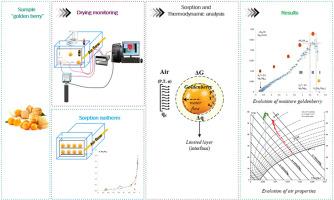Thermodynamic model and infrared thermography monitoring system for convective drying of goldenberry (Physalis peruviana)
IF 5.8
2区 农林科学
Q1 ENGINEERING, CHEMICAL
引用次数: 0
Abstract
The goldenberry (Physalis peruviana) is a highly perishable Andean fruit with valuable nutritional and functional properties. Its preservation poses a challenge due to its high moisture content. This study presents an integrated method combining infrared thermography (IR) and irreversible thermodynamics to characterize the convective drying process of goldenberry.Samples were dried at 60 °C and 1.0 m/s air velocity. Weight loss, surface temperature, and water activity were recorded over 13 h using thermocouples, precision balances, and IR imaging. An irreversible thermodynamic model was applied to estimate water flux, free energy changes, and chemical potential gradients, including mechanical energy effects. The phenomenological coefficient from Onsager's relation was correlated with water flux to describe internal water migration. IR thermography enabled real-time, non-invasive monitoring of temperature and emissivity, correlating with morphological changes during drying. Sorption isotherms were fitted using the GAB model, and thermodynamic analysis allowed separation of physical and mechanical contributions to water potential. This approach provides a deeper understanding of moisture transport during drying and demonstrates the usefulness of combining IR monitoring with thermodynamic modeling. It offers a promising tool for optimizing drying protocols in high-moisture tropical fruits like goldenberry.

杨梅对流干燥热力学模型及红外热成像监测系统
金莓(Physalis peruviana)是一种极易腐烂的安第斯水果,具有宝贵的营养和功能特性。由于其高含水量,它的保存提出了挑战。采用红外热像仪和不可逆热力学相结合的方法,对金梅的对流干燥过程进行了表征。样品在60°C和1.0 m/s风速下干燥。重量损失、表面温度和水活度在13小时内使用热电偶、精密天平和红外成像进行记录。应用不可逆热力学模型估计了水通量、自由能变化和化学势梯度,包括机械能效应。从Onsager关系中得到的现象系数与水通量相关,以描述内部水迁移。红外热成像能够实时、无创地监测温度和发射率,并与干燥过程中的形态变化相关。吸附等温线采用GAB模型拟合,热力学分析允许分离物理和机械对水势的贡献。这种方法提供了对干燥过程中水分输送的更深入的理解,并展示了将红外监测与热力学建模相结合的有用性。它为优化高水分热带水果如金莓的干燥方案提供了一个有前途的工具。
本文章由计算机程序翻译,如有差异,请以英文原文为准。
求助全文
约1分钟内获得全文
求助全文
来源期刊

Journal of Food Engineering
工程技术-工程:化工
CiteScore
11.80
自引率
5.50%
发文量
275
审稿时长
24 days
期刊介绍:
The journal publishes original research and review papers on any subject at the interface between food and engineering, particularly those of relevance to industry, including:
Engineering properties of foods, food physics and physical chemistry; processing, measurement, control, packaging, storage and distribution; engineering aspects of the design and production of novel foods and of food service and catering; design and operation of food processes, plant and equipment; economics of food engineering, including the economics of alternative processes.
Accounts of food engineering achievements are of particular value.
 求助内容:
求助内容: 应助结果提醒方式:
应助结果提醒方式:


